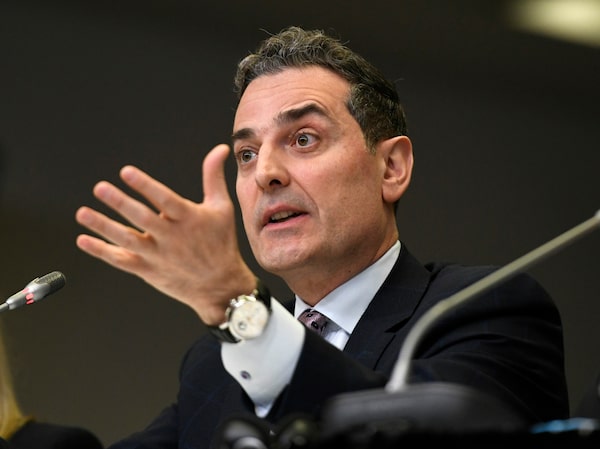
Mirko Bibic, president and CEO of BCE and Bell Canada, speaks during a CRTC hearing in Gatineau, Que., Feb. 19, 2020. Bibic said in an interview that the Ziply acquisition shows the company is on its 'front foot.'Justin Tang/The Canadian Press
Bell Canada parent BCE Inc. BCE-T is expanding into the United States by acquiring internet provider Ziply Fiber for $5-billion, while also putting dividend hikes on hold to help fix its balance sheet.
BCE investors sent the company’s share price tumbling nearly 10 per cent on Monday in reaction to the news. The company’s shares, at $40.47 each, are trading at the same level as in late 2011.
With the acquisition, announced early Monday, Canada’s largest telecommunications company will operate in four U.S. states in the Pacific Northwest – Washington, Oregon, Montana and Idaho – and provide fibre internet services to 1.3 million residential and business locations. BCE hopes to upgrade more of Ziply’s copper wire network to faster fibre over the next four years, bringing its total fibre connections to three million.
Credit rating agency Moody’s endorsed the transaction, calling it “credit positive” and “strategically appropriate.”
But the deal triggered critical reaction from some analysts, who questioned the company’s strategic shift in pausing dividend increases and spending heavily to acquire a company outside BCE’s current geographic footprint that could require significant capital expenditures in the coming years.
In a note to clients on Monday, Bank of Nova Scotia analyst Maher Yaghi said “investors in Canadian telecom are in the sector for dividends and not in it to get growth; they can get it elsewhere,” adding that “no dividend increases in the foreseeable future represents an important strategic change.”
In an analyst call Monday morning, Mr. Yaghi asked BCE chief executive officer Mirko Bibic, “Are you changing what BCE represents?”
“We’re leaning into our core business, which is to generate growth from fibre,” Mr. Bibic responded. “Fibre is a long-life infrastructure asset, and shareholders will benefit for, frankly, for decades to come,” he added later.
BCE has long been a popular name among investors seeking a high dividend yield, currently close to 10 per cent. But the telco is spending around 140 per cent of its free cash flow each year on dividends alone, and the company’s financial situation has been deteriorating because of a high debt load and slowing earnings growth. Two debt rating agencies downgraded BCE’s debt this summer.
Many investors expected the company to use the proceeds of the planned sale of its stake in Maple Leaf Sports & Entertainment (MLSE) to pay down debt.
Instead of doing so, BCE is using $4.2-billion in proceeds from MLSE on the Ziply purchase, and management signalled the acquisition could be the start of a broader expansion into the U.S.
Mr. Bibic said in an interview the acquisition shows the company is on its “front foot” in pursuing growth, and is swapping its equity investment in MLSE for operating earnings with upside from Ziply. “This is a great trade, in sports terms,” Mr. Bibic said.
The MLSE sale gave BCE options, because it “was either going to allow us to significantly reduce debt or seize the growth agenda that we had in mind.”
As for the dividend, BCE said Monday that it will pause dividend growth until its dividend payout and net debt leverage ratios are “tracking towards our target policy range.”
As BCE expands in the U.S., it will have to navigate the competitive nature of the U.S. broadband market.
Toronto Dominion Securities analyst Vince Valentini noted that the return on the deal would take several years.
“You just took your debt down, now you’re taking it back up. I think people will need to see something really attractive here to justify why you want to take on more debt so quickly,” Mr. Valentini said.
(BCE’s net debt leverage ratio at the transaction’s close is projected to remain relatively unchanged at 3.7 times adjusted earnings before interest, taxes, depreciation, and amortization, according to the company. That includes $2-billion of incremental Ziply net debt that BCE will assume.)
Ziply is forecast to generate EBITDA in excess of $400-million in 2025, according to BCE.
But Mr. Bibic said the majority of Ziply’s footprint did not face major competition or penetration of a type of cheaper internet offering called fixed wireless access which has been growing in the U.S. in recent years.
Aside from strategy, analysts also noted the reintroduction of a dividend reinvestment plan (DRIP) would be dilutive to existing shareholders.
The DRIP will allow investors to reinvest their dividends in additional BCE shares from its treasury at a 2-per-cent discount to the market. While this will allow BCE to conserve cash – about $1.2-billion annually if 35 per cent of shareholders participate, according to a TD Securities estimate – it will also add to BCE’s share count every year.